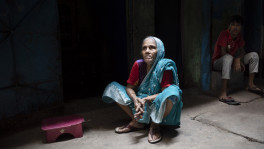India failed to save the living from covid-19. Now, it won't count the dead
Framing policy based on fudged numbers can only take us down the road of devastation again

For the past 10 days, at the peak of India's second covid-19 wave, I have traveled through remote villages in the country's most populous state, Uttar Pradesh, documenting corpses that have been dumped in our holiest rivers. I have counted hundreds of bodies abandoned in mass shallow graves molded from the sand and stones of dried-up riverbanks. My count stands at 1,000 bodies at six different towns, spread across a few hundred miles.
A formal audit will reveal many more bodies are out there. But no one will order it.
First, the Indian government failed abysmally at saving lives. Now, it is refusing to count our dead.
The distortion in death data has rendered thousands - maybe even hundreds of thousands - of Indians invisible. India's poor are dying unchronicled, uncounted and unacknowledged.
In Prime Minister Narendra Modi's parliamentary constituency of Varanasi, graves had to be dug for seven half-decomposed bodies that washed onto the shore, just a stone's throw away from a village Modi adopted under a government scheme.
In Prayagraj, named after the confluence of three rivers and rechristened from its Muslim name, Allahabad, by the Hindu nationalist strongman chief minister Yogi Adityanath, I found hundreds of bodies left by the riverside, with local residents asking, "Will the government ever bother to count our dead?"
And, by the very edge of the Ganges in the town of Unnao, where the waves of the water lashed against empty fields and there was not a person for miles, a local cowherd bore witness to the surge in bodies over the last few weeks, testifying to at least "two dead bodies, anonymously left in the sand, every day."
The ruling Bharatiya Janata Party has tried to gloss over these floating corpses by either pretending they don't exist or by offering ludicrous theories about it being an old custom that cannot be linked to covid-19. This is in the face of clear empirical evidence from eyewitnesses who testify to never having seen anything like this.
The flawed morality of this moment is obvious. But the absence of truth-telling in the number of covid-19 fatalities is also pushing the country toward peril again.
In February, self-congratulatory complacency led the Modi government to entirely ignore warnings of a second wave and make a series of fatal errors that has brought India to its knees. The carnage that has followed should have chastened us. Yet, data crunchers are in a hurry to declare the worst of the second wave over. There is talk of peaks moving to plateaus, without any cognizance of either the actual number of infections or deaths. Framing policy based on fudged numbers can only take us down the road of devastation again.
The abandoned bodies, bringing home the absence of dignity in death, are most likely a result of two factors. Many Indians in rural India do not have the money to pay for cremating their dead. In a year when daily wage workers are out of work because of prolonged lockdowns and a ravaged economy, the cost of wood to perform the last rites is simply unaffordable for many.

Stigma and fear around covid-19 are also leading to the dumping of bodies. The government has failed to dispel the misinformation and prejudice that has tailed the virus.
Even more unforgivable is the complete obfuscation of the carnage in India's villages. In the absence of access to testing facilities or hospitals, Indians are dying at home from what is being described as the "onset of sudden fever" in hamlet after hamlet. From the east to the west of Uttar Pradesh, every village I have been to is reporting a surge in sudden deaths. In Ramana village in Modi's constituency, the elected headman testified to "at least 40 deaths over the last three-four weeks." In Kannauj, villagers speak of "at least four or five cremations every day." And in Basi village, just two hours from the national capital, with a population of 5,000 people, the villagers say "not a single family has been untouched by fever."
Families are being wiped out with covid-19 symptoms without being documented. In Basi, I met the family of a father and son who died within an hour of one another. The father was only in his late 50s and was never tested for covid-19, not even when his oxygen levels crashed.
In Varanasi, 227 covid-19 deaths were reported for the period between April 1 and May 7. But the undertaker at a single cremation site told me he had cremated 2,800 bodies in a week. In Delhi, in the week when between 350 and 400 deaths were being reported as the daily casualty count, at a single funeral ground the undertaker said he was cremating more than 100 bodies every night. Despite the glaring gap in official numbers and overrun cremation grounds, there has not even been a perfunctory attempt to reconcile the data.
Indian citizens are being told they do not matter enough to even be a statistic.
Barkha Dutt is an award-winning TV journalist and anchor with more than two decades of reporting experience. She is the author of "This Unquiet Land: Stories from India's Fault Lines." Dutt is based in New Delhi.
Disclaimer: This article first appeared on The Washington Post, and is published by special syndication arrangement.


 Keep updated, follow The Business Standard's Google news channel
Keep updated, follow The Business Standard's Google news channel
















